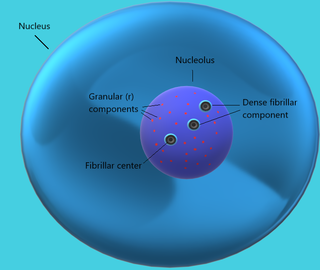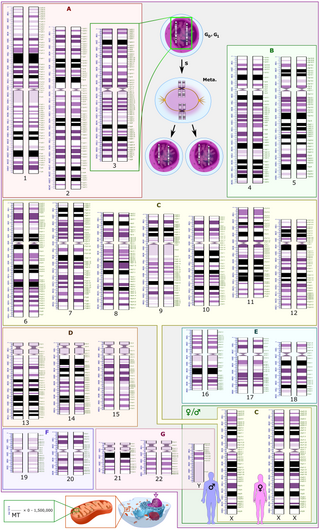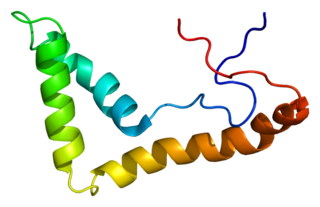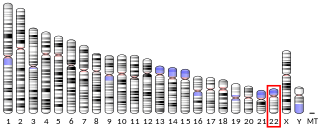
The nucleolus is the largest structure in the nucleus of eukaryotic cells. It is best known as the site of ribosome biogenesis, which is the synthesis of ribosomes. The nucleolus also participates in the formation of signal recognition particles and plays a role in the cell's response to stress. Nucleoli are made of proteins, DNA and RNA, and form around specific chromosomal regions called nucleolar organizing regions. Malfunction of nucleoli can be the cause of several human conditions called "nucleolopathies" and the nucleolus is being investigated as a target for cancer chemotherapy.

Ribosomal DNA (rDNA) is a DNA sequence that codes for ribosomal RNA. These sequences regulate transcription initiation and amplification, and contain both transcribed and non-transcribed spacer segments.

Treacle protein is a protein that in humans is encoded by the TCOF1 gene.

Satellite or SAT chromosomes are chromosomes that contain secondary constructs that serve as identification. They are observed in Acrocentric chromosomes. In addition to the centromere, one or more secondary constrictions can be observed in some chromosomes at metaphase. These chromosomes are called satellite chromosomes. In humans it is usually associated with the short arm of an acrocentric chromosome, such as in the chromosomes 13, 14, 15, 21, & 22. The Y chromosome can also contain satellites, although these are thought to be translocations from autosomes. The secondary constriction always keeps its position, so it can be used as markers to identify specific chromosomes.

Upstream binding transcription factor (UBTF), or upstream binding factor (UBF), is a protein that in humans is encoded by the UBTF gene.

60S ribosomal protein L7a is a protein that in humans is encoded by the RPL7A gene.

Pescadillo homolog is a protein that in humans is encoded by the PES1 gene.

U3 small nucleolar ribonucleoprotein protein IMP3 is a protein that in humans is encoded by the IMP3 gene.

Nucleolar protein 56 is a protein that in humans is encoded by the NOP56 gene.

60S ribosomal protein L10a is a protein that in humans is encoded by the RPL10A gene.

60S ribosomal protein L13a is a protein that in humans is encoded by the RPL13A gene.

40S ribosomal protein S20 is a protein that in humans is encoded by the RPS20 gene.

H/ACA ribonucleoprotein complex subunit 2 is a protein that in humans is encoded by the NHP2 gene.

40S ribosomal protein S8 is a protein that in humans is encoded by the RPS8 gene.

Ribosomal RNA processing protein 1 homolog A is a protein that in humans is encoded by the RRP1 gene.

60S ribosomal protein L15 is a protein that in humans is encoded by the RPL15 gene.

60S ribosomal protein L9 is a protein that in humans is encoded by the RPL9 gene.

Probable ribosome biogenesis protein RLP24 is a protein that in humans is encoded by the RSL24D1 gene.

U3 small nucleolar ribonucleoprotein protein IMP4 is a protein that in humans is encoded by the IMP4 gene.



















